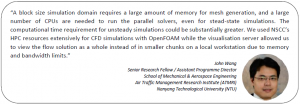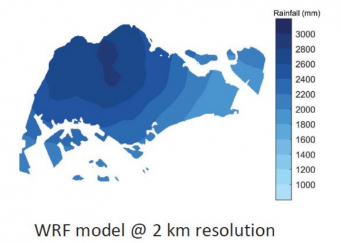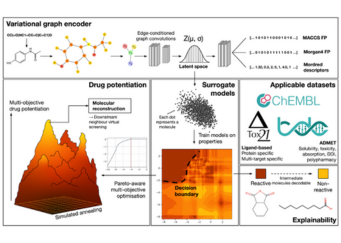Researchers from NTU tap on high performance computing to identify hazardous airspaces through urban weather simulations in order to facilitate effective route planning and management.
An important aspect of urban airspace utilisation that is often overlooked is the effect of building wake on the usability of the airspace. Given the relatively low crosswind and turbulence tolerance of a multirotor at cruise velocity, the crossing of an intersection with perpendicular funnelled flow could easily send the multirotor crashing into buildings or into the ground.
A team of researchers at Nanyang Technological University’s School of Mechanical & Aerospace Engineering, Air Traffic Management Research Institute, are leveraging on NSCC’s supercomputing resources to determine the fluid dynamic metrics that could be used to plot out hazardous airspaces to avoid based on prevailing surface wind conditions.
Urban wind field simulation was performed over a variety of terrain and buildings in order to identify very low-level airspace under or immediately above the building heights where funnelled, shear, or recirculating flow would pose a threat to multirotor stability or its track-keeping ability. Due to limitations with computational power and resolution of building models, only steady-state solutions could be used to construct the wind-field database.
The teams aims for the simulation studies to lead the way towards enabling Unmanned Aircraft System Traffic Management (UTM) service providers to identify hazardous airspaces to be geo-fenced out from usage and to enable route-replanning without encountering additional hazard.

To find out more about the NSCC’s HPC resources and how you can tap on them, please contact [email protected].
NSCC NewsBytes September 2023
Other Case Studies
Enhancing Weather Prediction in Singapore: Leveraging Climate Model Simulations for Precision
Researchers from NUS Tropical Marine Science Institute are leveraging supercomputing to fine-tune Weather Research and Forecasting (WRF) Model and downscale hundreds of years of...
Enhancing the safety of electric vehicles through HPC
Researchers from NUS tap on supercomputing to simulate the multi-physical processes of lithium-ion batteriesin order to develop cooling strategies for more advanced battery...
Advancing Drug Discovery Research using NSCC HPC resources
Researchers from Nanyang Technological University (NTU) are applying variational graph encoders as an effective generalist algorithm in computer-aided drug design (CADD)....


